Notable Saints
This is not a complete list of all saints mentioned on this wiki, just an overview of some of the saints whose cults are currently most active.
Saint Andrew
 Saint Andrew is the patron saint of Scotland and battles. Legend says that Óengus II, king of the Picts, was once heavily outnumbered when facing the Angles and appealed to Saint Andrew on the eve of battle. Óengus swore that he and his warriors would devote themselves to Saint Andrew should they win. On the day of the battle, the clouds above their encampment formed the shape of a great X, a saltire emblazoned across the sky. Óengus and his army were filled with great energy and courage. They fought hard and won the battle, despite their inferior numbers. Óengus kept his word and Saint Andrew gained many devotees across Scotland. Relics of Saint Andrew are held, appropriately, at the cathedral in the town of St Andrews, Scotland.
Saint Andrew is the patron saint of Scotland and battles. Legend says that Óengus II, king of the Picts, was once heavily outnumbered when facing the Angles and appealed to Saint Andrew on the eve of battle. Óengus swore that he and his warriors would devote themselves to Saint Andrew should they win. On the day of the battle, the clouds above their encampment formed the shape of a great X, a saltire emblazoned across the sky. Óengus and his army were filled with great energy and courage. They fought hard and won the battle, despite their inferior numbers. Óengus kept his word and Saint Andrew gained many devotees across Scotland. Relics of Saint Andrew are held, appropriately, at the cathedral in the town of St Andrews, Scotland.
Saint Andrew can be called upon to grant strategic advantages in battle, particularly when fighting a more powerful or numerous force.
Saint Arnold
Patron saint of brewers and winemakers. Alcoholic beverages are commonly consumed as the alcohol prevents sickness. He is famous for saving most of his parishioners from an outbreak of plague, a fact he attributed to the healthy effects of the beer he brewed. Those who follow the way of Saint Arnold devote themselves to supplying the world with good drink and merriment.
Arnold's boons include the ability to detect whether food or drink is safe to eat, and to ensure that cups never run dry.
Saint Bernard of Clairvaux
 The first Cistercian ever to be sainted (and some say the first real Cistercian), St Bernard believed in and still promotes the purity of the Church, free from garish, gaudy ritual, corrupting riches and earthly distractions. He particularly dislikes the Inquisitors as people who have fallen to earthly distractions.
The first Cistercian ever to be sainted (and some say the first real Cistercian), St Bernard believed in and still promotes the purity of the Church, free from garish, gaudy ritual, corrupting riches and earthly distractions. He particularly dislikes the Inquisitors as people who have fallen to earthly distractions.
Through prayer to Saint Bernard a devotee is able to maintain a clear mind through the greatest hardship or even martyrdom.
Saint Boniface
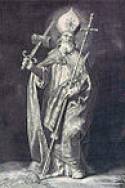 Saint Boniface, Scourge of Heretics, is the patron saint of the war against impure magic. Born in the Kingdom of Wessex circa 700 AD, he was the leader of the Christian mission to Germany. Perhaps his most famous act was the felling of Thor's Oak; a sacred tree whose leaves (as the legends have it) were stained red from the blood of generations of sacrifices. Boniface marched into the Pagan encampment around the site, alone, and began felling the tree with his axe. The Druids scrambled to attack him but a mighty wind blew up around him, throwing his assailants back whilst he chopped - stroke by stroke - through the trunk. When the tree fell the Druids' followers converted on the spot and, on Saint Boniface's orders, slew their former priests. He was martyred a decade later as he led a Christian army to victory against the last of the German pagans.
Saint Boniface, Scourge of Heretics, is the patron saint of the war against impure magic. Born in the Kingdom of Wessex circa 700 AD, he was the leader of the Christian mission to Germany. Perhaps his most famous act was the felling of Thor's Oak; a sacred tree whose leaves (as the legends have it) were stained red from the blood of generations of sacrifices. Boniface marched into the Pagan encampment around the site, alone, and began felling the tree with his axe. The Druids scrambled to attack him but a mighty wind blew up around him, throwing his assailants back whilst he chopped - stroke by stroke - through the trunk. When the tree fell the Druids' followers converted on the spot and, on Saint Boniface's orders, slew their former priests. He was martyred a decade later as he led a Christian army to victory against the last of the German pagans.
Saint Boniface is often called upon by those seeking his aid in battle, particularly against heathens.
Saint David
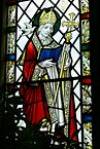 Patron saint of Wales and ascetics, Saint David was a nephew of King Arthur. He was renowned as both a preacher and leader in defence of Welsh independence against the Saxons. When not advising the Welsh lords (one piece of wisdom was that the Welsh soldiers should wear leeks on his helmet, so as to be easily recognisable to one another) he lived a life of extreme asceticism. He pulled the plough alongside the animals in his monasteries fields, fasted for months and - most memorably - stood for days on end neck-deep in local rivers, reciting scripture all the while.
Patron saint of Wales and ascetics, Saint David was a nephew of King Arthur. He was renowned as both a preacher and leader in defence of Welsh independence against the Saxons. When not advising the Welsh lords (one piece of wisdom was that the Welsh soldiers should wear leeks on his helmet, so as to be easily recognisable to one another) he lived a life of extreme asceticism. He pulled the plough alongside the animals in his monasteries fields, fasted for months and - most memorably - stood for days on end neck-deep in local rivers, reciting scripture all the while.
David's boons include the ability to endure immense physical hardship, starvation and deprivation. In return he desires his followers put themselves through those self-same trials; or act to aid the Welsh people.
Saint Edith
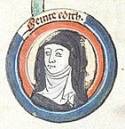
People say money cannot buy good works, but Queen Edith bought the services of enough worshippers to pray for her soul and enough gold to cover her relics and the jewelled casket in which they lie. They say she is still bitter that the inner casket is silver, rather than gold, and that she had to use rubies rather than emerald to replace her eyes. They say if you bring her sufficient gold and emeralds she will bestow favours upon you commensurate to the wealth you provided her. They say she walks Durham Cathedral at night to weigh up the day's offerings, and the brass scales on her shrine are there for that purpose. They say the eyes of Saint Edith can tell you where a dragon's hoard is located.
The miracles of St Edith focus on increasing the wealth and prosperity of those who devote themselves to her.
Saint Fritheswith
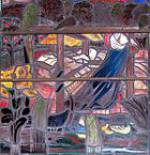 Fritheswith of Oxford, abbess and saint, has always had a soft spot for outlaws, and prayers and offerings made to her have been known to have beneficial effects for the giver. Many Christians say her kind nature and generous heart means she never refused the poor and desperate in life and in eternity she protects the weak and those without friends or family. Many outlaws will point out that the posse of guards sent after her came back blinded, that her pagan husband died under mysterious circumstances and that the wells which sprang up wherever she commanded flooded the houses of several of her critics, many of whom drowned in the deluge. It is something of a badge of honour among Christian outlaws to claim a greater kill count than St Fritheswith, or Frideswide.
Fritheswith of Oxford, abbess and saint, has always had a soft spot for outlaws, and prayers and offerings made to her have been known to have beneficial effects for the giver. Many Christians say her kind nature and generous heart means she never refused the poor and desperate in life and in eternity she protects the weak and those without friends or family. Many outlaws will point out that the posse of guards sent after her came back blinded, that her pagan husband died under mysterious circumstances and that the wells which sprang up wherever she commanded flooded the houses of several of her critics, many of whom drowned in the deluge. It is something of a badge of honour among Christian outlaws to claim a greater kill count than St Fritheswith, or Frideswide.
Fritheswith protects the weak and helpless who call to her for aid against those stronger than them.
Saint Galahad
Any relics of Galahad are unknown. He was the last known living person to have contact with the Holy Grail.
Knightly quests are often dedicated to Galahad.
Saint Genoveve
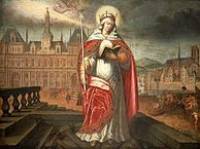 St Genoveve is the patron saint of Paris, and is, some say, the personal sponsor of the Capets. Certainly Geoffrey Duke of Brittany would have died had not King Philip of France personally carried him to the shrine of Saint Genoveve and prayed that he be spared. She also protects Paris, as is evidenced by the fact that a parade of her relics has defeated or re-routed invading forces like the Huns.
St Genoveve is the patron saint of Paris, and is, some say, the personal sponsor of the Capets. Certainly Geoffrey Duke of Brittany would have died had not King Philip of France personally carried him to the shrine of Saint Genoveve and prayed that he be spared. She also protects Paris, as is evidenced by the fact that a parade of her relics has defeated or re-routed invading forces like the Huns.
Genoveve's relics are famed for their healing powers, and ability to protect against invasions.
Saint George
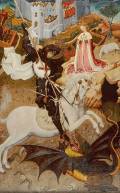 Patron saint of dragon slayers, monster hunters and England, George was martyred for his faith somewhere in the Byzantine Empire. He gained fame by slaying the dragon Bedelth, a plague-bearing dragon who once terrorised the lands near Oxford. In doing so he rescued a prince of the realm who he later married. His relics lie in the basilica of Saint Peter in Rome.
Patron saint of dragon slayers, monster hunters and England, George was martyred for his faith somewhere in the Byzantine Empire. He gained fame by slaying the dragon Bedelth, a plague-bearing dragon who once terrorised the lands near Oxford. In doing so he rescued a prince of the realm who he later married. His relics lie in the basilica of Saint Peter in Rome.
Saint George's boons aid those protecting good Christians against monsters of the wild.
Saint James the Greater
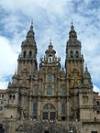 Patron saint of travelers. If you are on the road, you can invoke James the Greater for protection. Rumours have it that he will protect anyone regardless of faith if they invoke him with an earnest heart. Of course, some of those spreading that rumour have turned up dead. For details of his story, see Santiago de Compostela.
Patron saint of travelers. If you are on the road, you can invoke James the Greater for protection. Rumours have it that he will protect anyone regardless of faith if they invoke him with an earnest heart. Of course, some of those spreading that rumour have turned up dead. For details of his story, see Santiago de Compostela.
Saint James is a friend to travellers and pilgrims everywhere.
Saint Hild
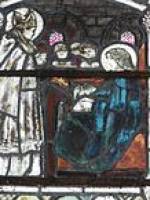 Hild was martyred by Danish Viking raiders when they overran Whitby Abbey prior just prior to the Norman Conquest. Choosing to die rather than fight, she held up her hands to the skies and offered sanctuary for all, whether Pagan or Christian, outlaw, peasant, freeman or noble, if they would avenge her death and draw down the wrath of all gods upon the heads of those who came to do her harm. Later retellings of this have emphasised that Hild will protect anything that is hers, so as long as an item or area is dedicated permanently to St Hild, it will enjoy a degree of protection.
Hild was martyred by Danish Viking raiders when they overran Whitby Abbey prior just prior to the Norman Conquest. Choosing to die rather than fight, she held up her hands to the skies and offered sanctuary for all, whether Pagan or Christian, outlaw, peasant, freeman or noble, if they would avenge her death and draw down the wrath of all gods upon the heads of those who came to do her harm. Later retellings of this have emphasised that Hild will protect anything that is hers, so as long as an item or area is dedicated permanently to St Hild, it will enjoy a degree of protection.
Saint Hild protects her own, so long as they respect good christian hospitality.
Saint Nonnata
Saint Nonnata is also known as the Keeper of Secrets, and is the patron of hidden pacts and the conversion of those lead astray by false Gods. She gained her fame in a mission to rescue Christians from a particularly vicious gang of Barbary Coast slavers. Upon arriving she was (perhaps predictably) captured by the pirates and chained up in a holding pen with the other slaves. Each night the slavers set one of their own to guard the captives, but each night Nonnata talked with them of the scripture, converted them to Christianity and bound them to absolute secrecy. Over the course of a month Nonnata's conspiracy amongst the slavers grew, until all but the Slaver King and his lieutenants (still unsuspecting) had been turned to the light. At this point Nonnata's converts began an uprising, imprisoning the Slaver King, freeing the captives and providing boats and provisions sufficient to reach Italy. Nonnata was later captured by the Moors, who prevented her from performing a repeat of her previous achievement by padlocking her lips together. She was martyred soon after.
Nonnata's boons include the ability to resist torture and to seal oaths.
The Lady of the Shadows
 The cult of the Shadow Lady was banned under an edict of William Rufus. Fountains Abbey in Yorkshire was build on the site of her shrine and her altar was replaced with one to Saint Edith.
The cult of the Shadow Lady was banned under an edict of William Rufus. Fountains Abbey in Yorkshire was build on the site of her shrine and her altar was replaced with one to Saint Edith.
Do not place devotions on that altar on Samhain or Midsummer Eve. Just… don't.
Saint Seiriol
The major patron saint of healing, St Seiriol first moved to Anglesey as a hermit, establishing Penmon Priory. Those disabled or ill who met the man or heard his sermons reported the miraculous healing of their ailments; it was not long before his legend had spread across the North of Wales. However the nearby druids of Bryn Celli Ddu were loath to accept the saints presence and soon running battles between the followers of Christianity and the Old Gods erupted in the streets of Caernarfon, culminating in a vast brawl outside Penmon Priory. With scores injured or dying St Seiriol himself stepped into the fray, healing followers of the trinity and Old Gods alike. With his intervention, and the saving of hundreds of lives, the battle stilled (allowing an uneasy truce to be later reached). But for St Seiriol, an old man, this final great use of his powers was too much and he expired within the year. But that is not the last of his story, for it is said that the well besides which his body was buried has gained a fragment of his healing powers.
Saint Seiriol is often prayed to to cure minor ailments, to cure the sick and to speed recovery from illness. Many of these requests are granted through priests devoted to him.
The Quattro Coronati
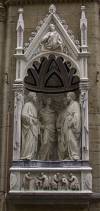 The Quattro Coronati are the four patron saints of masons and other craftsmen. Whilst originally their names were are unknown, it has been revealed that they were Claudia, Castoria, Simphorianus, and Nicostratus. The legend tells of how they were martyred by Empress Diocletian in 298 AD. The Empress had ordered that they erect a statue of one of the pagan gods of ancient Rome; being good Christians Claudia et al refused to partake in such idolatry. In return Diocletian had them sealed into lead coffins and thrown into the sea.
The Quattro Coronati are the four patron saints of masons and other craftsmen. Whilst originally their names were are unknown, it has been revealed that they were Claudia, Castoria, Simphorianus, and Nicostratus. The legend tells of how they were martyred by Empress Diocletian in 298 AD. The Empress had ordered that they erect a statue of one of the pagan gods of ancient Rome; being good Christians Claudia et al refused to partake in such idolatry. In return Diocletian had them sealed into lead coffins and thrown into the sea.
It is traditional to invoke a blessing in their name before starting a major building project to ensure the stability of a building's foundations, the strength of its walls and the safety of the workers. It is also said that the surest way to bring such a blessed building down upon one's head is to give them offence.
Saint Teilo
Saint Teilo gathered a significant following for himself in the early 500s. It was said he could ride anything. Once, told by a Pagan chieftain that he could keep all the land he could encircle from sunset to sunrise, he mounted a white stag to cover the greatest distance possible. Teilo is often depicted with a white stag because of this. But his two great obsessions were horses and churches; the latter of which his followers built in great numbers across Wales (and Northern France, from which he originally hailed). His body lies, uncorrupted, in St David's cathedral.
St Teilo's boons spur riding mounts and other domestic creatures to feats of vast endurance and strength. It is also said that dedicated rituals to Teilo can avert bad harvests, even in years of flood and famine. In return he desires the construction and enlargement of churches, especially in wild and uncivilised places.
Saint Thomas a Becket
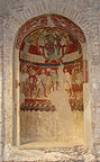 The former Archbishop of Canterbury, murdered by knights who took Henry II's outraged cry “Who will rid me of this troublesome priest!” literally. Henry himself petitioned the Pope for Becket to be declared saint and martyr, and since then the royal household has liberally donated to his shrine. He is now the patron saint of blacksmiths.
The former Archbishop of Canterbury, murdered by knights who took Henry II's outraged cry “Who will rid me of this troublesome priest!” literally. Henry himself petitioned the Pope for Becket to be declared saint and martyr, and since then the royal household has liberally donated to his shrine. He is now the patron saint of blacksmiths.
His chapel lies in Canterbury Cathedral and is covered in enough gold to feed a town for three years.
Thomas' favour aids those smithing weapons and armour. He is also popular with those wishing to curry favour with royals and the nobility.
Saint William
Brother of Empress Matilda, William had been named the heir to the throne before his untimely death following the sinking of the White Ship in 1120 AD. William is now the patron saint of sailors. The body was washed up on the shores of East Anglia and boiled down for relics: his bones now lie in Canterbury Cathedral. Rumours that his body was entwined with that of a fae beast are quashed on a regular basis.
Saint William is called upon to bless sea voyages and for good fishing.